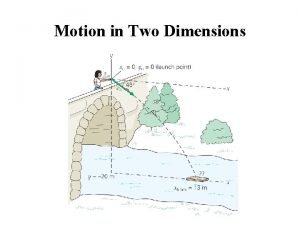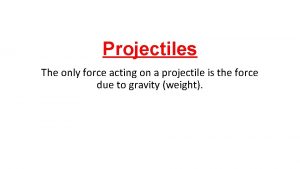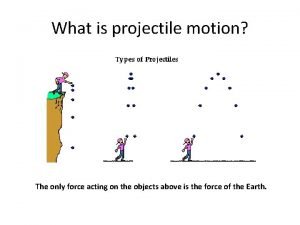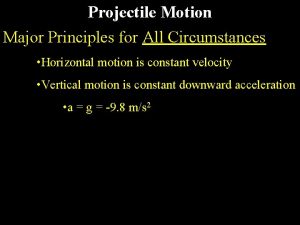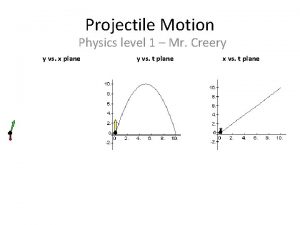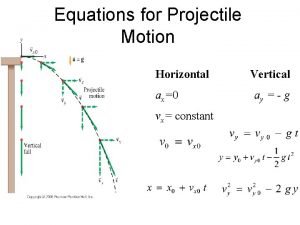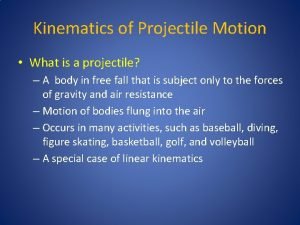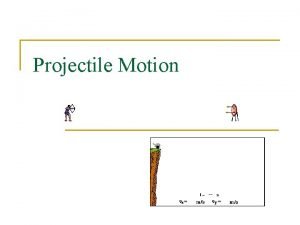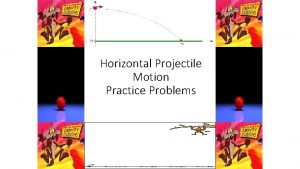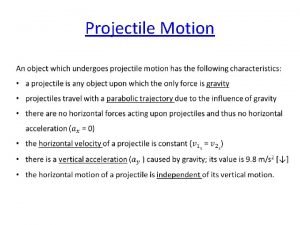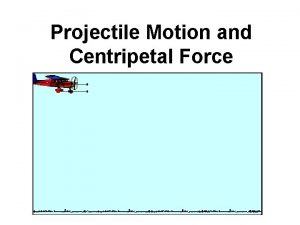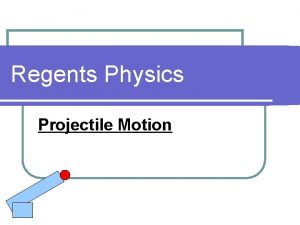Projectile Motion Components Horizontal Vertical Components review v









- Slides: 9

Projectile Motion Components

Horizontal & Vertical Components (review) v For a velocity vector v at an angle θ, θ the horizontal component is adjacent to the angle and the vertical component is opposite to the angle. We will use vx to talk about the horizontal component and vy to talk about the vertical component of the motion.

Projectile Motion Equations v • Launched horizontally: – vy, f = -(9. 8)t; Δy = - ½(9. 8)t 2 – vx, f = vx, i = constant; Δx = vxt • Launched at an angle: – vy, i = vi sinθ – vy, f = -vy, i = vi sinθ – 9. 8 t – Δy = vi sinθ t – ½ (9. 8)t 2 – vx, f = vx, I = vi cos θ – Δx = vi cosθ t v θ

Problem-Solving Strategy 1. Find time mid-air using vy, f = -vy, i = - vi sinθ = vi sinθ – 9. 8 t [you should know both vi and θ] This works because projectile motion is symmetric, so the object comes down with the same speed, just in a different direction (+ vs. -) 2. Find the range Δx using Δx = vi cosθ t 3. Find the maximum height using Δy = vi sinθ t – ½ (9. 8)t 2 and plugging in half of the total time for t. This works again because projectile motion is symmetric, so the object spends half its time going up and half going down.

Example • A football is kicked with an initial velocity of 18 m/s at an angle of 42° with the horizontal. Find the time of flight, the horizontal displacement, and the maximum height of the football. • You know: – vi = –θ= v θ

Finding Time of Flight vy, f = -vy, i = - vi sinθ = vi sinθ – 9. 8 t Start by finding vy, f = - vi sinθ = - (18 m/s) sin(42°) = - 12 m/s Then, plug into the equation at the top: - 12 m/s = 12 m/s – 9. 8 t - 24 m/s = -9. 8 t t = 24/9. 8 = 2. 45 seconds

Finding Range Δx = vi cosθ t Use the time of flight we just found as well as the initial velocity & angle to find the range. Δx = 18 cos(42°) t = 13. 4(2. 45) = 32. 8 m

Finding Maximum Height Δy = vi sinθ t – ½ (9. 8)t 2 Use half of our time of flight (2. 45 seconds) as well as our initial velocity & angle to find the maximum height of the football. Δy = 18 sin(42°)(1. 23) – ½ (9. 8)(1. 23)2 = 12(1. 23) – ½ (9. 8)(1. 51) = 14. 76 – 7. 40 = 7. 36 m

Independent Practice • A long jumper leaves the ground with an initial velocity of 10 m/s at an angle of 26° above the horizontal. Determine the time of flight, range, and maximum height of the long jumper. • You know: – vi = –θ= v θ
 Projectile motion displacement formula
Projectile motion displacement formula Only force acting in a projectile
Only force acting in a projectile The only force acting in a horizontal projectile motion is
The only force acting in a horizontal projectile motion is Projectile motion principles
Projectile motion principles Site:slidetodoc.com
Site:slidetodoc.com Horizontal projectile motion formula
Horizontal projectile motion formula Projectile motion formula
Projectile motion formula Projectile motion horizontal distance
Projectile motion horizontal distance Factors influencing projectile trajectory
Factors influencing projectile trajectory Projectile motion on inclined plane
Projectile motion on inclined plane
